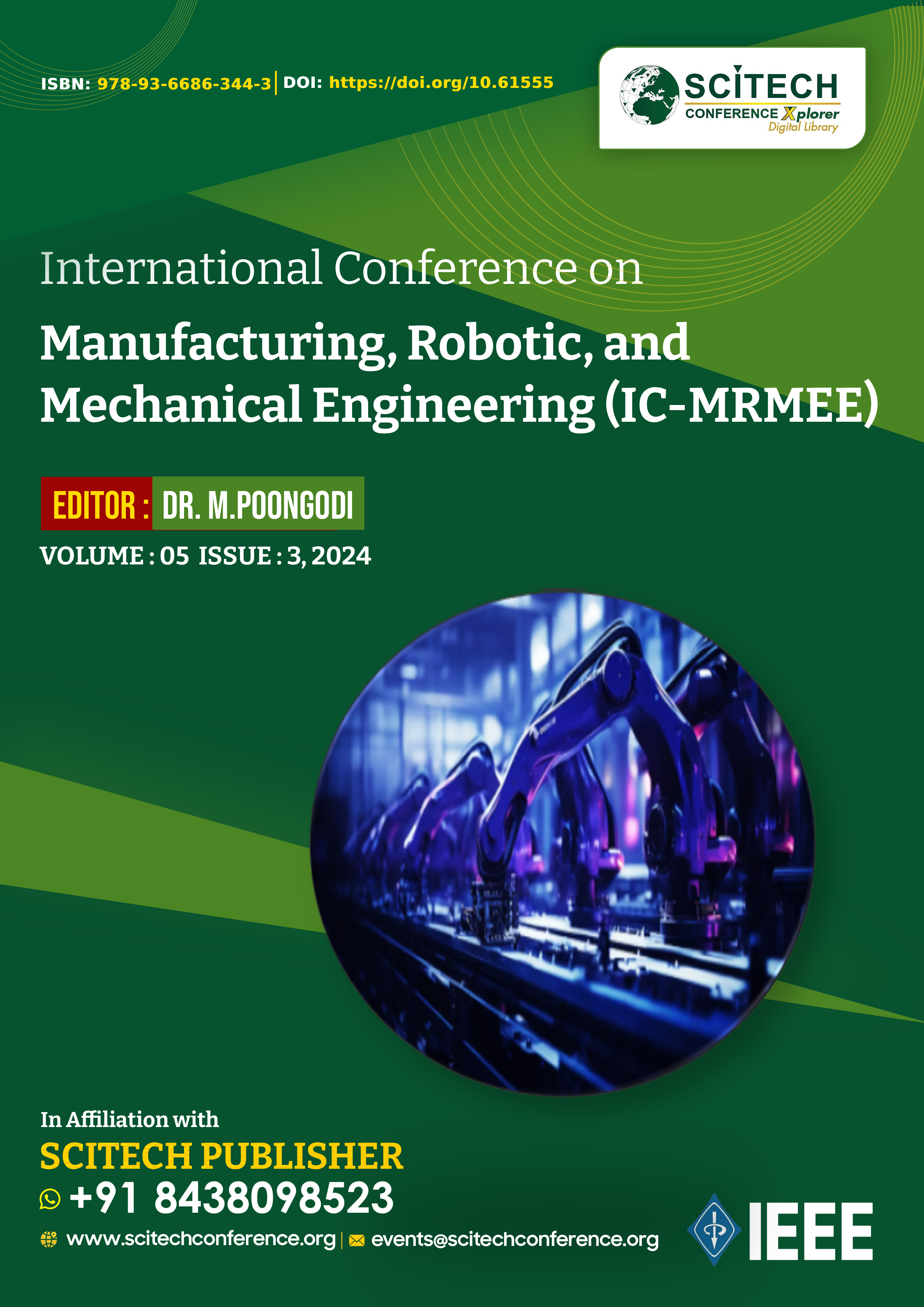International Conference on Manufacturing, Robotic, and Mechanical Engineering (IC-MRMEE)

Articles
An Investigation Of Tourist Potential For The Development Of Tourist Corridor – Nh 32, Tamilnadu, India
Ar.Mohanapriya.R, Prof.Dr.Kumudhavalli Sasidhar
Year: 2024 | Conference Paper | Publisher: Scitech Conference Xplorer
Abstract:
Tamil Nadu, a southern State of India is flooded with places of great traditional, cultural, religious and heritage significance and also has become a place of tourism significance. Tourism has o...Read MoreEmployee Life Cycle -a Model Reference To Organisational Work-life Balance
Dr. Rathnakar Gatla, Dr. Naresh Boora
Year: 2024 | Conference Paper | Publisher: Scitech Conference Xplorer
Abstract:
The current proliferation of employee engagement research in human resource development (HRD) has advanced our theoretical understanding of the nature of employee engagement and i...Read MoreThe Role of Artificial Intelligence in Optimizing Renewable Energy Systems
Steven Chu, Arun Majumdar
Year: 2024 | Conference Paper | Publisher: Scitech Conference Xplorer
Abstract:
Keywords: artificial intelligence, renewable energy systems, machine learning, predictive analytics, energy optimization, grid stability, smart meters, IoT sensors, energy forecasting, resource allocation, sustainability.
Microgrids: Decentralized Energy Systems for Urban and Rural Applications
Steven Chu, Yi Cui, Nian Liu
Year: 2024 | Conference Paper | Publisher: Scitech Conference Xplorer
Abstract:
Keywords: microgrids, decentralized energy systems, energy reliability, grid resilience, renewable energy integration, urban microgrids, rural microgrids, energy storage, control systems, case studies, energy security, economic development.
Advancements in Nanomaterials for Electronics and Photonics Applications
Shengjie Ling, David L Kaplan, Markus J Buehler
Year: 2024 | Conference Paper | Publisher: Scitech Conference Xplorer
Abstract:
Keywords: nanomaterials, electronics, photonics, graphene, carbon nanotubes, quantum dots, high-mobility transistors, flexible electronics, nanophotonics, plasmonics, light-emitting devices, advanced sensors, device fabrication, material scalability.
High-Temperature Superconductors: Materials, Properties, and Applications
Brian S Mitchell
Year: 2024 | Conference Paper | Publisher: Scitech Conference Xplorer
Abstract:
Keywords: high-temperature superconductors, HTS materials, cuprates, iron-based superconductors, nickelates, critical temperature, magnetic field tolerance, electrical conductivity, power transmission, magnetic levitation, medical imaging, material synthesis, fabrication challenges, advanced materials.
Robotic Surgery: Innovations and Trends in Minimally Invasive Procedures
Chenguang Yang, Yiming Jiang, Wei He, Jing Na, Zhijun Li, Bin Xu
Year: 2024 | Conference Paper | Publisher: Scitech Conference Xplorer
Abstract:
Keywords: robotic surgery, minimally invasive procedures, surgical robotics, advanced imaging, robotic platforms, single-port systems, flexible endoscopes, artificial intelligence, machine learning, telemedicine, surgical planning, clinical outcomes, surgical precision.
Exoskeletons for Rehabilitation: Enhancing Mobility and Independence
Enrique J deAndrés-Galiana, Juan Luis Fernández-Martínez, Stephen T Sonis
Year: 2024 | Conference Paper | Publisher: Scitech Conference Xplorer
Abstract:
Keywords: exoskeletons, rehabilitation technology, mobility enhancement, independence, assistive devices, physical therapy, adaptive control systems, patient outcomes, wearable robots, rehabilitation protocols, technical challenges, future research.
Advanced Computational Techniques for High-Resolution Medical Imaging
Joseph N Mait, Gary W Euliss, Ravindra A Athale
Year: 2024 | Conference Paper | Publisher: Scitech Conference Xplorer
Abstract:
Keywords: computational techniques, high-resolution imaging, medical imaging, image reconstruction, iterative reconstruction, compressed sensing, machine learning, artificial intelligence, hybrid imaging, diagnostic accuracy, imaging algorithms, clinical integration.
Deep Learning Approaches in Computational Imaging: Applications and Innovations
Roland Eils, Chaitanya Athale
Year: 2024 | Conference Paper | Publisher: Scitech Conference Xplorer
Abstract:
Keywords: deep learning, computational imaging, convolutional neural networks, image analysis, medical imaging, satellite imaging, industrial inspection, automated segmentation, anomaly detection, image enhancement, dataset requirements, model generalizability.
International Conference on Sustainable Energy and Materials Engineering (ICSEME)
International Conference on Biomedical Robotics and Computational Imaging (ICBRCI)
International Conference on Smart Cities and Civil Infrastructure (ICSCCI)
International Conference on Aerospace Technologies and Data Science (ICATDS)
International Conference on Renewable Resources and Chemical Engineering (ICRRCE)
International Conference on Cyber-Physical Systems and Electrical Engineering (ICCPSE)
International Conference on Robotics in Manufacturing and Environmental Engineering (ICRMEE)
International Conference on Advanced Materials and Mechanical Engineering (ICAMME)
International Conference on Nanotechnology for Electrical Systems (ICNES)
International Conference on Geotechnical Innovations and Computer-Aided Design (ICGICAD)
International Conference on Water Resources and Environmental Engineering (ICWREE)
International Conference on Intelligent Transportation Systems and Structural Engineering (ICITSE)
International Conference on Sustainable Energy and Materials Engineering (ICSEME)
International Conference on Biomedical Robotics and Computational Imaging (ICBRCI)
International Conference on Smart Cities and Civil Infrastructure (ICSCCI)
International Conference on Aerospace Technologies and Data Science (ICATDS)
International Conference on Renewable Resources and Chemical Engineering (ICRRCE)
International Conference on Cyber-Physical Systems and Electrical Engineering (ICCPSE)
International Conference on Robotics in Manufacturing and Environmental Engineering (ICRMEE)
International Conference on Advanced Materials and Mechanical Engineering (ICAMME)
International Conference on Nanotechnology for Electrical Systems (ICNES)
International Conference on Geotechnical Innovations and Computer-Aided Design (ICGICAD)
International Conference on Water Resources and Environmental Engineering (ICWREE)
International Conference on Intelligent Transportation Systems and Structural Engineering (ICITSE)
International Conference on Sustainable Energy and Materials Engineering (ICSEME)
International Conference on Biomedical Robotics and Computational Imaging (ICBRCI)
International Conference on Smart Cities and Civil Infrastructure (ICSCCI)
International Conference on Aerospace Technologies and Data Science (ICATDS)
International Conference on Renewable Resources and Chemical Engineering (ICRRCE)
International Conference on Cyber-Physical Systems and Electrical Engineering (ICCPSE)
International Conference on Robotics in Manufacturing and Environmental Engineering (ICRMEE)
International Conference on Advanced Materials and Mechanical Engineering (ICAMME)
International Conference on Nanotechnology for Electrical Systems (ICNES)
International Conference on Geotechnical Innovations and Computer-Aided Design (ICGICAD)
International Conference on Water Resources and Environmental Engineering (ICWREE)
International Conference on Intelligent Transportation Systems and Structural Engineering (ICITSE)

+91 9888374777
icmsetm@scitechconference.org







